How Much Farmers Spend On Pest Control Every Year
Pests can cause severe damage for farmers. They can damage our natural environment and destroy our food production and agriculture industries. They place significant stress
The Tractors That Founded Queensland and Where To Find Them
As the days of horse-pulled ploughs and teams of men working the fields came to an end, it was the tractor that launched Australia into
Maintaining Livestock Welfare – Is Your Livestock Fit For The Journey?
The trade of transporting and exporting livestock comes with numerous regulations and requirements which legally must be followed or else breaches could result in drastic
Australian Wool Industry & Why Queensland Is ‘Built on a Sheep’s Back’
Australia is one of the largest producers of wool in the world. We produce around 25 percent of greasy wool sold on the market. The
Advertising For Agricultural Seasonal Workers? Here Are Some Tips!
Thousands of Australian agri-business or farms rely on seasonal workers to handle the surge of labour needed each harvest. Previously, a large portion of this
6 Aussie Agriculture Facts You Might Not Know
Curious about the agriculture industry? Australia has a thriving agricultural scene – from small hobby farms to sprawling acres of crop, there is so much
Megatrends Shaping Australian Agriculture
Research conducted by the ABARES and CSIRO has revealed five key ‘megatrends’ that are set to shape Australia’s food and fibre industries in the coming
5 Australian Women in Agriculture You Should Know
The stereotype that your typical Aussie farmer is a blokey man who wears a straw hat is outdated. In fact, according to the Department of
A Tour Though Broken Hill – Movies, Mining, Drag & More
G’day everyone, your favourite well-travelled delivery driver is back. It’s Uncle Garry’s Aussie Country Town Tour part 2! Last week I shared my tour through
Why Plastic Parts Are Rapidly Overtaking Metal
Plastic vs metal – it’s a long-debated topic in agricultural, mechanical, automotive and several other industries. While metal parts and assets have been king since
Why Your Poly Tank Colour Is More Important Than You Might Think
So, you’ve decided to buy a water storage tank. Once you have chosen your tank size, type and location on your property, it’s time to
Aussie Country Town Tour – A Country Man’s Guide Through Mildura
G’day everyone, Uncle Garry from Global Rotomoulding here. Welcome to my first post of Gazz’s Aussie Country Town Tour, where I’ll take you through some

